|
Web log, Earth date 2007.11, science officer Richard McGinlay
recording. Analysis of the stardates used in the various incarnations
of the Star Trek television and movie series have revealed
the numerical system to contain a number of peculiar anomalies.
For example, the dates appear not to have progressed at a
consistent rate over the years, and sometimes they even seem
to run backwards! Should we therefore disregard this obviously
flawed system? Further sensor readings are required...
All
Star Trek fans know what stardates are. They’re
those silly numbers with a decimal point that the captains
of all the Trek series (with the exception of Star
Trek: Enterprise) have used to record the passage of time
in a non-Gregorian way.
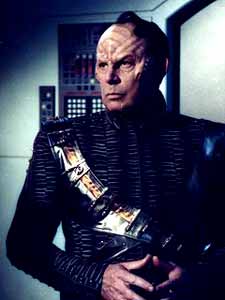 In
Trek mythology, it appears that the stardate system
is adopted across the Federation some time between 2161 (the
end of Star Trek: Enterprise) and 2265 (the
year in which the Original Series episode Where
No Man Has Gone Before is now assumed to take
place). Stardates are seen to be in use as far back as the
2150s, by species including the Vulcans and the Xindi, though
Earth has not yet embraced the system at this time. In the
episode Damage,
the Xindi-Primate Degra sends a coded message containing co-ordinates
and a stardate for where and when the Enterprise should
rendezvous with his ship. T’Pol is able to determine
that the stardate is three days hence. In
Trek mythology, it appears that the stardate system
is adopted across the Federation some time between 2161 (the
end of Star Trek: Enterprise) and 2265 (the
year in which the Original Series episode Where
No Man Has Gone Before is now assumed to take
place). Stardates are seen to be in use as far back as the
2150s, by species including the Vulcans and the Xindi, though
Earth has not yet embraced the system at this time. In the
episode Damage,
the Xindi-Primate Degra sends a coded message containing co-ordinates
and a stardate for where and when the Enterprise should
rendezvous with his ship. T’Pol is able to determine
that the stardate is three days hence.
Behind
the scenes, stardates were originally invented in order to
remind viewers that the show is set in a distant future, without
tying the series down to a specific year or even a specific
century. Creator Gene Roddenberry was all too aware that the
pace of technological change can be hard to predict - who
knew how many years it would take for interstellar travel
or transporter technology to become a reality? The captain’s
log voice-overs were also useful devices for recapping the
story so far following a commercial break.
Later
on, the movie Star
Trek II: The Wrath of Khan
specified the century (the 23rd), before the Next
Generation
episode The Neutral Zone mentioned the year for the
first time (2364). However, stardates remained in use throughout
TNG, Deep
Space Nine
and Voyager, as part of the traditional Star Trek
formula.
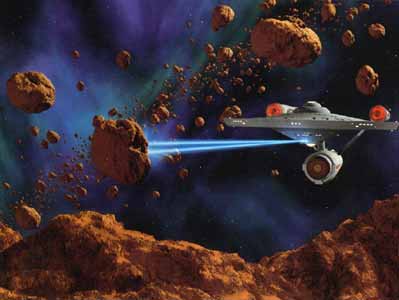 Unfortunately,
despite having the best of reasons for introducing the concept
of stardates, Roddenberry failed to devise a proper system
with which writers could apply them. Little thought was given
to the numbers used in The Original Series, except
that they generally increased over time. Unfortunately,
despite having the best of reasons for introducing the concept
of stardates, Roddenberry failed to devise a proper system
with which writers could apply them. Little thought was given
to the numbers used in The Original Series, except
that they generally increased over time.
Any
viewers who have paid much attention to The Original Series
and The Animated Series will probably have noticed
that stardates often don’t progress in either production
order or broadcast order. This is partly because, when the
episodes were filmed, the production team had little or no
idea in which sequence the television network would choose
to transmit them. However, this is not really a problem: we
can simply assume that the events take place in a different
order to that in which they were produced or aired.
What
is more difficult to explain is how stardate time seems to
progress at different rates over different periods. For instance,
the duration of Captain Kirk’s initial five-year mission
on board the USS Enterprise appears to take place between
the stardates 1310.0 (around the time of Where No Man)
and 7405.0 (after the events of the animated episode Bem).
This implies that each year of that mission lasts for approximately
1200 stardate units. In light of this calculation, the gap
of just 0015.0 stardate units between the end of Where
No Man and the beginning of Mudd’s Women seems
incredibly small when you consider all the upgrades that the
starship and its crew’s uniforms evidently undergo between
the two episodes (which, in the real world, were due to sets
and costumes being redesigned between the production of the
second pilot and the first season proper).
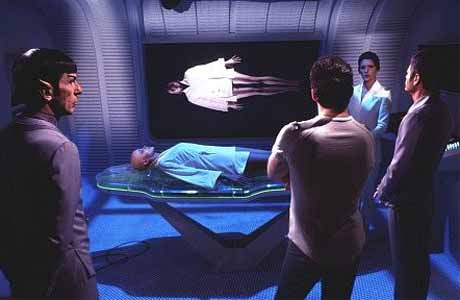 However,
that’s nothing compared to the miniscule gap of less
than 0008.0 stardate units that exists between the end of
Bem (stardate 7403.6) and the beginning of Star
Trek: The Motion Picture
(stardate 7410.2), during which time Admiral Kirk spends two
and a half years away from the captain’s chair serving
as Chief of Starfleet Operations! However,
that’s nothing compared to the miniscule gap of less
than 0008.0 stardate units that exists between the end of
Bem (stardate 7403.6) and the beginning of Star
Trek: The Motion Picture
(stardate 7410.2), during which time Admiral Kirk spends two
and a half years away from the captain’s chair serving
as Chief of Starfleet Operations!
There
are also several instances in which the values of stardates
contradict the explicit order of events, while on other occasions
the dates of certain episodes overlap each other.
Should
we therefore simply disregard stardates? I don’t think
so. They are as much a part of Star Trek mythology
as transporters, tricorders and warp drive. To ignore them
would be like ignoring Captain Kirk’s middle initial,
another staple ingredient of Trek that hasn’t
always been applied consistently.
The
first time we encounter Kirk’s middle initial, in the
episode Where No Man Has Gone Before, it is inscribed
on a gravestone that his super-powered former friend Gary
Mitchell has created. It reads: “James R Kirk”.
However, every subsequent reference to Kirk’s middle
name has been “T” or “Tiberius”. Do were
therefore ignore the fact that Kirk has a middle name? No,
of course we don’t. Do we take the first instance as
canon and the rest as mistakes? No: we accept the vast majority
of instances that are consistent (all the instances of “T”
and “Tiberius”) and dismiss the minority (the single
instance of “R”).
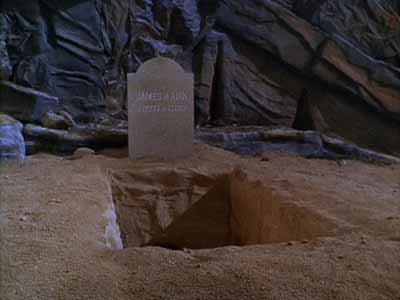 We
can go further, though, by attempting to rationalise the anomalous
minority. In his trilogy of novels My Brother’s Keeper,
Michael Jan Friedman suggests that the initial “R”
is a private joke shared by Kirk and Mitchell that stands
for various things, including “racquetball” (“Racquetball?
That’s practically my middle name!”) and even “rhinoceros”.
Following this line of reasoning, it could also stand for
Republic, the vessel on which these men first served
together on a training mission. Or it might mean “rulebook”,
given Mitchell’s recollection, in Where No Man
of Kirk being “a stack of books with legs” in his
academy days. Peter David’s novel Q-Squared implies
that the events of Where No Man take place in a parallel
universe. Alternatively, maybe Jim lied to Gary about his
middle name, to prevent being teased about it. We
can go further, though, by attempting to rationalise the anomalous
minority. In his trilogy of novels My Brother’s Keeper,
Michael Jan Friedman suggests that the initial “R”
is a private joke shared by Kirk and Mitchell that stands
for various things, including “racquetball” (“Racquetball?
That’s practically my middle name!”) and even “rhinoceros”.
Following this line of reasoning, it could also stand for
Republic, the vessel on which these men first served
together on a training mission. Or it might mean “rulebook”,
given Mitchell’s recollection, in Where No Man
of Kirk being “a stack of books with legs” in his
academy days. Peter David’s novel Q-Squared implies
that the events of Where No Man take place in a parallel
universe. Alternatively, maybe Jim lied to Gary about his
middle name, to prevent being teased about it.
We
can approach stardates in the same way: accept the instances
that make sense, and disregard or attempt to explain those
that do not.
When
pressed for an explanation for the oddities surrounding stardates,
Gene Roddenberry once came out with the following: “This
time system adjusts for shifts in relative time which occur
due to the vessel’s speed and space-warp capability.
It has little relationship to Earth’s time as we know
it. One hour aboard the USS Enterprise at different
times may equal as little [sic] as three Earth hours. The
stardates specified in the log entry must be computed against
the speed of the vessel, the space warp, and its position
within our galaxy, in order to give a meaningful reading.”
 Roddenberry
later admitted that he hadn’t really understood what
he had said: “I’m not quite sure what I meant by
that explanation, but a lot of people have indicated it makes
sense. If so, I’ve been lucky again, and I’d just
as soon forget the whole thing before I’m asked any further
questions about it.” Roddenberry
later admitted that he hadn’t really understood what
he had said: “I’m not quite sure what I meant by
that explanation, but a lot of people have indicated it makes
sense. If so, I’ve been lucky again, and I’d just
as soon forget the whole thing before I’m asked any further
questions about it.”
The
relativistic explanation is nonsense, because if starship
crews really were susceptible to such effects when travelling
at high velocities, the time dilation they experienced would
be in the region of years or centuries, not mere hours or
days. Therefore we must accept that warp-drive technology
ordinarily avoids the issue of time dilation, because its
method of warping (bending) space effectively shortens the
distance between two points.
It
is more likely that disparities in stardate progression can
be attributed to variations in local space-time conditions.
The Original Series episode The Naked Time suggests
that the ship’s chronometers are able to display relative
time, as determined by an external source, rather than subjective
time - how else can the chronometer on Sulu’s panel determine
that the ship is travelling backwards in time? The TNG
episode Cause and Effect reveals that it is sometimes
necessary for Starfleet vessels to contact a nearby time beacon
in order to re-synchronise their internal chronometers following
exposure to local temporal distortion.
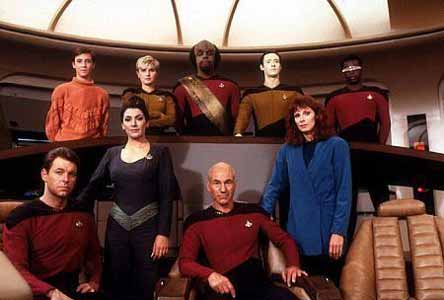 When
The Next Generation went into production, efforts were
made to devise a more cohesive system of stardates. This used
five-digit numbers, initially starting with a 4 (representing
the 24th century), followed by the season number. Thus, first-season
stories have stardates that begin 41---, second-season stories
are indicated by 42---, and so on. After a fairly shaky start,
these dates progressed in an orderly fashion. Deep Space
Nine and Voyager retained the same system, though
the numbers eventually increased to the point at which the
first digit was 5 (this digit does not represent the 25th
century). When
The Next Generation went into production, efforts were
made to devise a more cohesive system of stardates. This used
five-digit numbers, initially starting with a 4 (representing
the 24th century), followed by the season number. Thus, first-season
stories have stardates that begin 41---, second-season stories
are indicated by 42---, and so on. After a fairly shaky start,
these dates progressed in an orderly fashion. Deep Space
Nine and Voyager retained the same system, though
the numbers eventually increased to the point at which the
first digit was 5 (this digit does not represent the 25th
century).
In
this era, each television season occupies one Earth year in
the Star Trek universe. Thus, 1000 stardate units are
equivalent to one year. One stardate unit is equal to 0.36525
days, or 08 hours 45 minutes 57.6 seconds. In another words,
one Earth hour equals slightly more than 0.114 stardate units
(give or take the aforementioned variations in local space-time
conditions).
It
is commonly supposed that 24th-century stardates are aligned
so that a stardate divisible by 1000 occurs close to the start
of a year on the Gregorian calendar. However, there is clear
evidence to dispute this. When Captain Picard visits France
in the episode Family (stardate 44012.3) the sunny
weather suggests spring, summer or early autumn rather than
winter. In Data’s Day, the android logs a stardate
of 44390.1 and states that the ship is preparing to celebrate
the Hindu festival of lights. Otherwise known as Diwali, this
celebration occurs each year during mid- to late October or
early to mid-November. Taking this evidence into account,
the start of each year on the Gregorian calendar would occur
around the stardate --600.0 mark. Stardates divisible by 1000
would therefore occur some time around June.
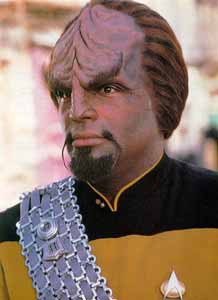 Working
backwards from the established date of The
Neutral Zone,
the five-digit dating system would appear to have started
around the middle of the year 2322. This is illustrated in
the following timeline, which includes the dates of some key
events, such as the Khitomer Massacre, which is mentioned
in the episode Sins of the Father as having taken place
in the year 2346 and on stardate 23859.7... Working
backwards from the established date of The
Neutral Zone,
the five-digit dating system would appear to have started
around the middle of the year 2322. This is illustrated in
the following timeline, which includes the dates of some key
events, such as the Khitomer Massacre, which is mentioned
in the episode Sins of the Father as having taken place
in the year 2346 and on stardate 23859.7...
Stardate 00000.0 = June 2322
Stardate 00600.0 = January 2323
Stardate 01000.0 = June 2323
Stardate 02000.0 = June 2324
Stardate 03000.0 = June 2325
Stardate 04000.0 = June 2326
Stardate 05000.0 = June 2327
Stardate 06000.0 = June 2328
Stardate 07000.0 = June 2329
Stardate 08000.0 = June 2330
Stardate 09000.0 = June 2331
Stardate 10000.0 = June 2332
Stardate 20000.0 = June 2342
Stardate 23859.7 (the Khitomer Massacre) = April 2346
Stardate 30000.0 = June 2352
Stardate 40000.0 = June 2362
Stardate 41153.7 (Encounter at Farpoint) = July 2363
Stardate 41986.0 (The Neutral Zone) = May 2364
Stardate 44012.3 (Family) = June 2366
Stardate 44390.1 (Data’s Day) = October 2366
Stardate 48000.0 = June 2370
Stardate 48632.4 (Star
Trek: Generations)
= January 2371
Stardate 50000.0 = June 2372
This
suggests that a different stardate system is in use prior
to 2322. Perhaps this year witnesses a crucial turning point
in Federation history, which is marked by the new dating system,
rather like the adoption of Anno Domini a couple of millennia
ago.
Once
we accept the likelihood that stardates are reset to zero
during the 24th century, we invite speculation that the sequence
may have gone though a number of previous resets.
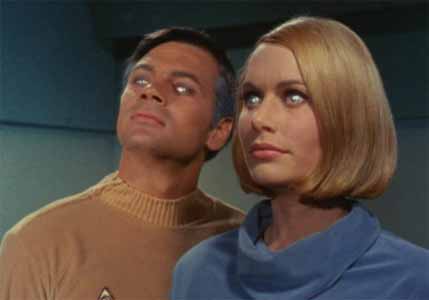 For
example, in Where No Man (stardate 1312.4-1313.8),
onscreen medical records for Gary Mitchell and Elizabeth Dehner
show their dates of birth as stardate 1087.7 and stardate
1089.5 respectively. Mitchell’s age is recorded as 23,
Dehner’s as 21. One interpretation of these figures is
that stardates passed far more slowly during the years leading
up to 2265, with just one stardate unit being roughly equivalent
to one Earth year! It’s understandable that this system
might prove unpopular, because of the need for excessive numbers
of decimal places in order to represent accurate dates, which
might explain the adoption of “faster” dates by
stardate 1110.7 (1087.7 + 23). For
example, in Where No Man (stardate 1312.4-1313.8),
onscreen medical records for Gary Mitchell and Elizabeth Dehner
show their dates of birth as stardate 1087.7 and stardate
1089.5 respectively. Mitchell’s age is recorded as 23,
Dehner’s as 21. One interpretation of these figures is
that stardates passed far more slowly during the years leading
up to 2265, with just one stardate unit being roughly equivalent
to one Earth year! It’s understandable that this system
might prove unpopular, because of the need for excessive numbers
of decimal places in order to represent accurate dates, which
might explain the adoption of “faster” dates by
stardate 1110.7 (1087.7 + 23).
However,
Kirk’s gravestone in the same episode shows a birth date
of stardate 1277.1. How can this fit in with the above? It
is extremely unlikely that Kirk is younger than Mitchell.
Some fans believe that 1277.1 may refer to the date on which
Kirk assumed command of the Enterprise.
Alternatively,
it could be that four-digit stardates are routinely reset
about once every decade. This would mean that the numbers
cycle back around to zero once between the birth of Kirk and
that of Mitchell, and twice between Dehner’s birth and
the events of Where No Man. This would also mean that
Mitchell and Dehner are born within hours of each other, but
that is entirely possible, if coincidental. The ages shown
on their medical records could indicate their ages at the
time of their respective medical examinations rather than
their current ages.
This
notion of “resetting the clock” could also account
for the stardate of 2794.7 attributed to Governor Kodos’s
slaughter of more than 4,000 of his own people on Tarsus IV,
which is said to occur some twenty years before the events
of The Conscience of the King (stardate 2817.6-2819.8).
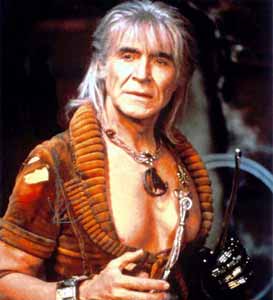 It
also ties in with the gap of fifteen years that is said to
elapse between Space Seed (3141.9-3143.3) and Star
Trek II: The Wrath of Khan (8130.3-8141.6), whilst explaining
the seemingly small stardate gaps between Star Trek: The
Motion Picture and Star Trek II, and between Star
Trek V: The Final Frontier
(8454.1) and Star
Trek VI: The Undiscovered Country
(9521.6-9529.1). It
also ties in with the gap of fifteen years that is said to
elapse between Space Seed (3141.9-3143.3) and Star
Trek II: The Wrath of Khan (8130.3-8141.6), whilst explaining
the seemingly small stardate gaps between Star Trek: The
Motion Picture and Star Trek II, and between Star
Trek V: The Final Frontier
(8454.1) and Star
Trek VI: The Undiscovered Country
(9521.6-9529.1).
Presumably there is some way of distinguishing cycles of stardates
when necessary, such as calling them First Cycle or First
Series, Second Cycle or Second Series, etc, though this would
only ever be required when referring to previous cycles -
in much the same way that, whenever anybody today refers to
the ’90s, we assume that they mean the 1990s unless otherwise
indicated.
You may have noticed that I keep on using words like “about”
and “approximately”. This is because, even assuming
that stardates cycle around every decade or so, the durations
of these cycles are not entirely consistent. They seem to
vary between approximately 900 stardate units to one Earth
year during the time of the Tarsus tragedy, to about 1200
stardate units per year during the time of Captain Kirk’s
first five-year mission in command of the USS Enterprise.
This may be explained by variances in local space-time conditions.
If we assume that some galactic phenomenon, such as a pulsar,
is used as the benchmark for measuring stardates, then this
could be influenced by temporal effects or spatial expansion
occurring between the object and the site where observations
are made of it. By 2322, it appears that such anomalies have
been overcome, perhaps owing to improvements in scanning technology
or the selection of a point of reference that is not so prone
to local effects. (My bafflegab is beginning to sound a bit
like Mr Roddenberry’s now!)
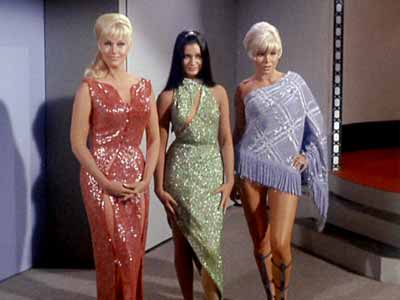 There
remain some specific inconsistencies in certain episodes,
but these are relatively easy to resolve... There
remain some specific inconsistencies in certain episodes,
but these are relatively easy to resolve...
For
his first log entry in the episode Mudd’s Women,
Kirk records a stardate of 1329.8. However, two subsequent
log entries are dated earlier than this (1329.1 and 1329.2
respectively). I assume 1329.8 to be a slip of the tongue
and that Kirk actually means 1328.9.
The
stardate gap between the end of Where No Man (1313.8)
and the beginning of Mudd’s Women seems too small
to accommodate all the equipment upgrades that the Enterprise
has evidently undergone in the meantime. Some fans have speculated
that during The Original Series stardates reflect the
duration of each individual vessel or colony’s mission,
rather than being synchronised throughout the Federation.
Stardates might therefore be suspended whenever a ship is
taken off active duty for lengthy repairs or refitting, as
appears to be the case here.
If
this is the case, then the Enterprise’s stardates
for the events of The
Doomsday Machine
are not known. Commodore Decker of the USS Constellation
records a log entry for stardate 4202.1, but modifications
to Enterprise equipment and uniforms in episodes with
seemingly earlier stardates suggest that the Enterprise’s
dates are not “in synch” with those of the Constellation.
Production-wise, this is the first episode in which Kirk wears
his second-season wraparound costume and the only episode
in which its V-neck lacks a black trim. Production order would
place this episode immediately before Wolf in the Fold
(3614.9), which provides a convenient explanation for Uhura’s
absence from The Doomsday Machine: she’s recovering
from her brain wipe in The Changeling (3541.9). This
would mean that the logs of the Enterprise and the
Constellation are “out of synch” to the tune
of approximately 0600.0 stardate units, or about five to six
months, which may be an indication of how long the Enterprise’s
refit lasted between Where No Man and Mudd’s
Women.
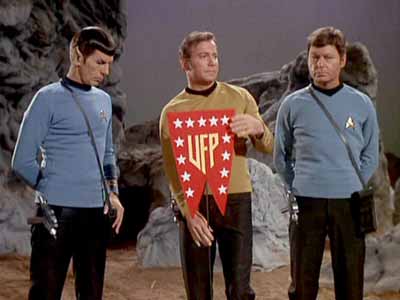 This
theory may also explain why Professor Starnes’s log for
the science colony on Triacus in And
the Children Shall Lead
is out of synch with the Enterprise’s logs by
at least 0011.0 stardate units. In the episode, the ship arrives
at Triacus on stardate 5029.5. However, when the late Professor
Starnes’ reports are played back, they cover the period
5025.3-5038.3. This
theory may also explain why Professor Starnes’s log for
the science colony on Triacus in And
the Children Shall Lead
is out of synch with the Enterprise’s logs by
at least 0011.0 stardate units. In the episode, the ship arrives
at Triacus on stardate 5029.5. However, when the late Professor
Starnes’ reports are played back, they cover the period
5025.3-5038.3.
It
could also account for the miniscule stardate gap that exists
between the end of the animated episode Bem (7403.6)
and the beginning of The Motion Picture (7410.2), if
we assume that the Enterprise’s stardates are
suspended during its extensive refit.
Perhaps
the purpose of such hiatuses is to give a better indication
of ships’ and bases’ operational lifespans. Maybe
this is why Admiral Morrow thinks the Enterprise is
only twenty years old in The
Search for Spock:
it could actually be close to that figure in terms of actual
years of service. Alternatively, Morrow might just be getting
confused by the stardates, especially since, by the time of
The Wrath of Khan, the Federation appears to have abandoned
the idea of individual vessels and settlements using their
own stardate systems (the USS Reliant’s stardates
seem to be synchronous with those of the Enterprise).
On a couple of occasions, Original Series episodes
clash with each other in terms of their stardates. Kirk’s
log entries in The Man Trap cover the period 1513.1-1513.8,
which falls right in the middle of The Corbomite Maneuver
(1512.2-1514.1). Similarly, the stardates for Dagger of
the Mind (2715.1-2715.2) conflict with those of Miri
(2713.5-2717.3). I assume that Kirk actually says “thirty”
rather than “thirteen” in The Man Trap and
“fifty” rather than “fifteen” in Dagger
of the Mind, giving us stardates of 1530.1-1530.8 and
2750.1-2750.2 respectively.
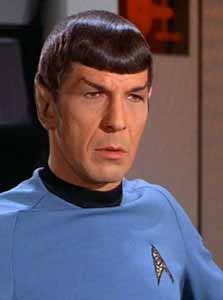 Similarly,
in The Conscience of the King (stardate 2817.6-2819.8),
Spock estimates that the ship will arrive at the Benecia Colony
on stardate 2825.3, but The Galileo Seven spans the
stardates 2821.5-2823.1. Evidently the ship accelerated once
the murderer had been discovered and was able to improve on
Spock’s estimate. Similarly,
in The Conscience of the King (stardate 2817.6-2819.8),
Spock estimates that the ship will arrive at the Benecia Colony
on stardate 2825.3, but The Galileo Seven spans the
stardates 2821.5-2823.1. Evidently the ship accelerated once
the murderer had been discovered and was able to improve on
Spock’s estimate.
For
his first log entry in The Deadly Years, Kirk records
a stardate of 3478.2, but for his second entry he says 3579.4.
I take this to be an early indication of senility caused by
his accelerated ageing and that he actually means 3479.4.
Similarly,
the initial log entry in Spock’s Brain is stardate
5431.4, but the second one is for stardate 4351.5. Again,
I think matters are preying on the captain’s mind: he
is worried about his first officer’s stolen brain, and
probably means to say 5431.5. He also gets the designation
of the planet Sigma Draconis VI wrong, twice referring to
it as Sigma Draconis VII - that’s how worried
he is!
At
least three episodes of The Animated Series contain
invalid stardates. The Magicks of Megas-Tu is said
to take place on stardate 1254.4, which would place it before
Where No Man Has Gone Before. However, the uniform
and bridge design do not reflect this. The Eye of the Beholder
seemingly occurs on stardate 5501.2, which places it in the
middle of The Ambergris Element (5499.9-5506.2). The
Practical Joker is apparently set during stardate 3183.3,
but it must actually take place after The Enterprise Incident
(5027.3-5027.4) because it shows Romulans using Klingon-designed
D-7 class battle cruisers.
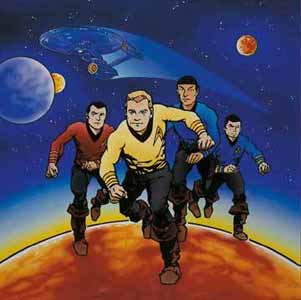 In
the timeline at the end of this feature, I have placed The
Magicks of Megas-Tu in production order, after Mudd’s
Passion (4978.5). The Eye of the Beholder has also
been placed in production order, between The Terratin Incident
(5577.3-5577.7) and Once Upon a Planet (5591.2). I
have placed The Practical Joker just before How
Sharper Than a Serpent’s Tooth (6063.4-6063.5), again
in production order. The explanation for these erroneous stardates
(shown as strikethrough text in my timeline) could be computer
error. The Enterprise’s computer systems are seen
to fail in The Magicks of Megas-Tu, and a gaseous energy
field affects the computer in The Practical Joker.
I’m not suggesting that the crew do not know what the
date is when they make their log entries, but that the computer
erroneously adjusts the voice recordings of certain dates,
rather like a present-day computer with an inaccurate internal
clock assigning misleading modification dates to files. In
the timeline at the end of this feature, I have placed The
Magicks of Megas-Tu in production order, after Mudd’s
Passion (4978.5). The Eye of the Beholder has also
been placed in production order, between The Terratin Incident
(5577.3-5577.7) and Once Upon a Planet (5591.2). I
have placed The Practical Joker just before How
Sharper Than a Serpent’s Tooth (6063.4-6063.5), again
in production order. The explanation for these erroneous stardates
(shown as strikethrough text in my timeline) could be computer
error. The Enterprise’s computer systems are seen
to fail in The Magicks of Megas-Tu, and a gaseous energy
field affects the computer in The Practical Joker.
I’m not suggesting that the crew do not know what the
date is when they make their log entries, but that the computer
erroneously adjusts the voice recordings of certain dates,
rather like a present-day computer with an inaccurate internal
clock assigning misleading modification dates to files.
In
my timeline, you may notice that I have placed Star Trek
II: The Wrath of Khan in the year 2282. Most chronologies
place the film later than this, despite both Kirk and Khan
referring to the events of Space Seed (2267) as having
taken place fifteen years earlier. This is because the vintage
of the Romulan ale that McCoy gives Kirk as a birthday present
is described as “2283”. However, “2283”
could be a stardate, which would make the ale more than five
years old.
In
Star Trek III: The Search for Spock, the Vulcan’s
death at the end of the previous film is said to have occurred
on stardate 8128.7, according to the Enterprise’s
flight recorder, but Star Trek II occurs during stardates
8130.3-8141.6. Either the ship’s log or its flight recorder
must be out by about ten stardate units. I choose to believe
that it is the flight recorder that is in error, because otherwise
it would mean that both Saavik and Chekov (on board the Reliant)
get their dates wrong independently. It is not unreasonable
to suppose that the Enterprise’s flight recorder
might not be quite up to specs, as the ship is only expected
to be used for brief training cruises.
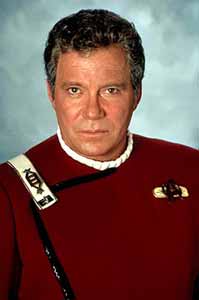 Admiral
Kirk’s recap at the start of some versions of Star
Trek IV: The Voyage Home
refers to the stardate as 8031, which would place it before
Star Trek II. However, I’m not convinced that
this log entry is canonical, because Kirk also tells us that
it is “the 23rd century” - who is he addressing
that might not know what century it is? Rather, I see this
log entry as non-canonical narration for the purposes of bringing
uninitiated viewers up to date with the story so far. This
recap was not included on all prints of the film, only on
those shown in Europe and South America, and it has never
been released in the USA. If you wish to accept this prologue
as canon (perhaps Kirk refers to the century in case future
generations discover the recording), then he simply makes
a mistake with the date or the Klingon ship’s log recorder
skips a digit and what he really means to say is stardate
8331.0. Admiral
Kirk’s recap at the start of some versions of Star
Trek IV: The Voyage Home
refers to the stardate as 8031, which would place it before
Star Trek II. However, I’m not convinced that
this log entry is canonical, because Kirk also tells us that
it is “the 23rd century” - who is he addressing
that might not know what century it is? Rather, I see this
log entry as non-canonical narration for the purposes of bringing
uninitiated viewers up to date with the story so far. This
recap was not included on all prints of the film, only on
those shown in Europe and South America, and it has never
been released in the USA. If you wish to accept this prologue
as canon (perhaps Kirk refers to the century in case future
generations discover the recording), then he simply makes
a mistake with the date or the Klingon ship’s log recorder
skips a digit and what he really means to say is stardate
8331.0.
On
to The Next Generation, and in Encounter at Farpoint
Data claims that he graduated from “Starfleet Class of
’78”, but the later episode The Neutral Zone
reveals that the series takes place in the 2360s. I theorise
that Data is referring to a class located on Starbase 78.
As
I indicated earlier in this feature, the stardates used in
TNG proved to be more organised than those used in
previous series - but only after a shaky start. The numbers
heard in the first season are all over the place. If you were
to list these episodes in stardate order, then Tasha Yar would
participate in several episodes after she has died in Skin
of Evil (stardates 41601.3-41602.1). Dialogue also indicates
that the episode 11001001 (41365.9) follows directly
on from Datalore (41242.4-41242.5), though the stardates
suggest otherwise. Other factors to be taken into consideration
include references in Coming of Age (41416.2) to (amongst
other episodes) The Battle (41723.9).
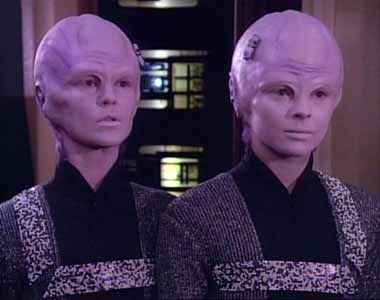 It
is interesting to note that, in Coming of Age, the
investigator Remmick states that he has discovered “several
discrepancies” in Picard’s log entries. Could this
be evidence that some stardates are less reliable than others?
Then there’s the fact that the Enterprise computer
receives an upgrade from the Bynars in 11001001. I
believe that this could be partly prompted by glitches in
the computer’s recording of stardates, as I suggested
for the anomalous dates in The Animated Series. It
is interesting to note that, in Coming of Age, the
investigator Remmick states that he has discovered “several
discrepancies” in Picard’s log entries. Could this
be evidence that some stardates are less reliable than others?
Then there’s the fact that the Enterprise computer
receives an upgrade from the Bynars in 11001001. I
believe that this could be partly prompted by glitches in
the computer’s recording of stardates, as I suggested
for the anomalous dates in The Animated Series.
My
timeline places the affected episodes in what I believe to
be a best-fit compromise, preserving as many of the transmitted
stardates as possible while also taking into account production
order where feasible. As with the Animated Series anomalies,
those marked with strikethrough text have been adjusted by
me, and are followed by suggestions for what the “true”
stardates might be. This does leave quite a few episodes taking
place between 41153.7 and 41365.9. This is because I am working
on the assumption that the computer glitch is corrected shortly
after the events of 11001001. The Last Outpost’s
stardate must also be deemed unreliable, because it has to
happen before The Battle, which itself must take place
before Coming of Age.
In
Dark Page, a diary entry referring to Lwaxana Troi’s
marriage to Ian Andrew Troi, supposedly in the 2330s, has
a stardate of 30620.1. Working backwards from the dates used
elsewhere in TNG, that stardate would occur in the
year 2353. Unless we assume that Betazoids grow up super-fast
and that Deanna Troi is just ten years old in the first season
of TNG, 30620.1 cannot be a true Federation stardate.
Perhaps the planet Betazed has different stardates to the
majority of the quadrant. Perhaps the Betazoids got tired
of resetting the four-digit dates to zero every decade and
so switched to their own five-digit system several years ahead
of the rest of the Federation.
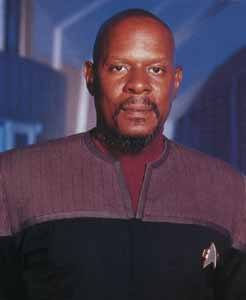 On
to Deep Space Nine now, and in the episode Second
Sight (stardate 47329.4), Captain Sisko claims that it
is the fourth anniversary of the Battle of Wolf 359, which
occurred in the two-part TNG story The Best of Both
Worlds (43989.1-44001.4). However, going by the stardates,
that’s a gap of little more than three years. Fortunately,
it has been established that Deep Space Nine operates on Bajoran
time, with 26 hours in each day, so it seems logical to apply
this to years too. Therefore, Sisko could be referring to
Bajoran years, which must therefore be about 300 Terran days
long. On
to Deep Space Nine now, and in the episode Second
Sight (stardate 47329.4), Captain Sisko claims that it
is the fourth anniversary of the Battle of Wolf 359, which
occurred in the two-part TNG story The Best of Both
Worlds (43989.1-44001.4). However, going by the stardates,
that’s a gap of little more than three years. Fortunately,
it has been established that Deep Space Nine operates on Bajoran
time, with 26 hours in each day, so it seems logical to apply
this to years too. Therefore, Sisko could be referring to
Bajoran years, which must therefore be about 300 Terran days
long.
And
talking of the Borg, in the episode In Purgatory’s
Shadow, Sisko mentions the “recent Borg attack”,
presumably the one depicted in Star
Trek: First Contact
(50893.5). However, in the very next instalment, By Inferno’s
Light, a stardate of 50564.2 is logged, which would place
In Purgatory’s Shadow before First Contact.
It is possible that Sisko is referring to the Borg confrontation
in William Shatner’s novel The Return, which probably
occurred about a year and a half previously, between Star
Trek: Generations (48632.4-48650.1) and The Way of
the Warrior (49011.4).
The
timeline that follows does not cover the entirety of Trek
history. It deals only with the period from the birth of James
T Kirk to the end of the first season of TNG. This
is because, with the exception of Second Sight and
In Purgatory’s Shadow, which are explained above,
I don’t feel that any of the stardates after this period
are in question.
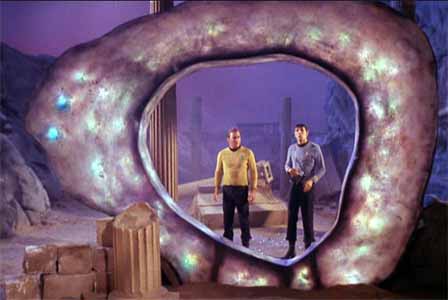 Several
broadcast episodes do not contain stardates. Some of these
have been allocated stardates in other sources, such as reference
guides and fotonovels - only a couple of which I have accepted.
For instance, many sources suggest dates of 3134.0 and 2534.0
respectively for The City on the Edge of Forever and
Patterns of Force. These dates are taken from early
draft scripts of the episodes. However, these dates deviate
significantly from the shows’ production order, so I
have disregarded them in favour of production order. This
way, we also avoid having two time-travel stories next to
each other (City and Tomorrow is Yesterday). Several
broadcast episodes do not contain stardates. Some of these
have been allocated stardates in other sources, such as reference
guides and fotonovels - only a couple of which I have accepted.
For instance, many sources suggest dates of 3134.0 and 2534.0
respectively for The City on the Edge of Forever and
Patterns of Force. These dates are taken from early
draft scripts of the episodes. However, these dates deviate
significantly from the shows’ production order, so I
have disregarded them in favour of production order. This
way, we also avoid having two time-travel stories next to
each other (City and Tomorrow is Yesterday).
Conversely,
in his novel Q-Squared, Peter David suggests a stardate
of 3823.7 for Mirror, Mirror, which I have taken on
board because it does not conflict with the production order
(unlike Diane Duane’s suggestion of 4428.9 in her novel
Dark Mirror). Similarly, I have accepted the stardate
that reference book authors have assigned to A Piece of
the Action (4598.0), which is apparently based on an early
script, because it still follows production order, taking
place before By Any Other Name (4657.5). The fotonovel
of this episode offers a concluding stardate of 4598.7.
Because
most of the animated episodes occur in between episodes of
the live-action series, I have distinguished their production
codes with the letter “A”.

Timeline:
circa 2230-2364
Circa 2230
Stardates commence or are reset to 0000.0
One year = about 900 stardate units at this point
Circa 2231
Stardate 1277.1: James Tiberius Kirk is born (Where
No Man Has Gone Before)
Circa 2241
Stardates are reset to 0000.0
Circa 2242
Stardate 1087.7: Gary Mitchell is born (Where
No Man Has Gone Before)
Stardate 1089.5: Elizabeth Dehner is born (Where
No Man Has Gone Before)
Circa
2244
Stardate 2794.7: Governor Kodos of Tarsus IV slaughters more
than 4,000 people (The Conscience of
the King)
Circa 2252
Stardates are reset to 0000.0
2254
#101 The Cage Stardate unknown
Circa 2263
Stardates are reset to 0000.0 and by now reflect the duration
of individual ships’ and colonies’ missions
One year = about 1200 stardate units at this point
2264
Stardate 1116.4: Harcourt Fenton Mudd’s master’s
licence to operate a ship is revoked (Mudd’s
Women)
2265
#102 Where No Man Has Gone Before
Stardate 1312.4-1313.8
Stardate circa 1320.0: the Enterprise’s stardates
are suspended during its repairs and refit
2266
#104 Mudd’s Women Stardate
1329.8 1328.9-1330.1
#103 The Corbomite Maneuver Stardate
1512.2-1514.1
#106 The Man Trap Stardate 1513.1-1513.8
1530.1-1530.8
#108 Charlie X Stardate 1533.6-1535.8
#105 The Enemy Within Stardate
1672.1-1673.1
#107 The Naked Time Stardate
1704.2-1704.4
#109 Balance of Terror Stardate
1709.2-1709.6
#119 The Squire of Gothos Stardate
2124.5-2126.3
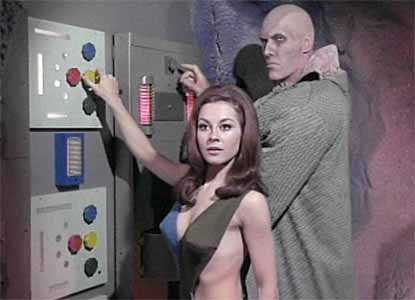
2267
#110 What are Little Girls Made of?
Stardate 2712.4
#112 Miri Stardate 2713.5-2717.3
#111 Dagger of the Mind Stardate
2715.1-2715.2 2750.1-2750.2
#113 The Conscience of the King
Stardate 2817.6-2819.8
#114 The Galileo Seven Stardate
2821.5-2823.1
#115 Court Martial Stardate 2947.3-2950.1
#116 The Menagerie, Part I Stardate
3012.4-3012.6
#117 The Menagerie, Part II Stardate
3013.1-3013.2
#201 Catspaw Stardate 3018.2
#118 Shore Leave Stardate 3025.3-3025.8
#120 Arena Stardate 3045.6-3046.2
#121 The Alternative Factor Stardate
3087.6-3088.7
#122 Tomorrow is Yesterday Stardate
3113.2-3114.1
#125 Space Seed Stardate 3141.9-3143.3
#123 The Return of the Archons
Stardate 3156.2-3158.7
#124 A Taste of Armageddon Stardate
3192.1
#127 The Devil in the Dark Stardate
3196.1
#128 Errand of Mercy Stardate
3198.4-3201.7
#217 The Gamesters of Triskelion
Stardate 3211.7-3212.2
#202 Metamorphosis Stardate 3219.8-3220.3
#129 The City on the Edge of Forever
Stardate unknown
#130 Operation -- Annihilate!
Stardate 3287.2-3289.8
#205 Amok Time Stardate 3372.7
#126 This Side of Paradise Stardate
3417.3-3417.7
#204 Who Mourns for Adonais?
Stardate 3468.1
#211 The Deadly Years Stardate
3478.2-3579.4 3479.4
#203 Friday’s Child Stardate
3497.2-3499.1
#208 The Changeling Stardate
3541.9
#206 The Doomsday Machine Stardate
unknown (Constellation log: 4202.1)
#207 Wolf in the Fold Stardate
3614.9-3615.4
#218 Obsession Stardate 3619.2-3620.7
#209 The Apple Stardate 3715.0-3715.6
2268
#210 Mirror, Mirror Stardate
3823.7
#215 Journey to Babel Stardate
3842.3-3843.4
#214 Bread and Circuses Stardate
4040.7-4041.7
#A11 The Slaver Weapon Stardate
4187.3
#216 A Private Little War Stardate
4211.4-4211.8
#219 The Immunity Syndrome Stardate
4307.1-4309.4
#302 Elaan of Troyius Stardate
4372.5
#301 Spectre of the Gun Stardate
4385.3
#212 I, Mudd Stardate 4513.3
#213 The Trouble With Tribbles
Stardate 4523.3-4525.6
#220 A Piece of the Action Stardate
4598.0-4598.7
#221 By Any Other Name Stardate
4657.5
#224 The Ultimate Computer Stardate
4729.4-4731.3
#222 Return to Tomorrow Stardate
4768.3-4770.3
#223 Patterns of Force Stardate
unknown
#225 The Omega Glory Stardate
unknown
#226 Assignment: Earth Stardate
unknown
#303 The Paradise Syndrome Stardate
4842.6-4843.6

2269
#A08 Mudd’s Passion Stardate
4978.5
#304 The Enterprise Incident Stardate
5027.3-5027.4
#305 And the Children Shall Lead
Stardate 5029.5 (Triacus log: 5025.3-5038.3)
#A09 The Magicks of Megas-Tu
Stardate 1254.4 circa 5100.0
#308 The Empath Stardate 5121.5
#A05 The Survivor Stardate 5143.3-5148.7
#A04 Beyond the Farthest Star
Stardate 5221.3-5221.8
#A10 The Time Trap Stardate 5267.2-5267.6
#A18 Albatross Stardate 5275.6-5276.8
#A07 One of Our Planets is Missing
Stardate 5371.3-5372.1
#A03 Yesteryear Stardate 5373.4-5373.9
#A01 More Tribbles, More Troubles
Stardate 5392.4
#317 The Mark of Gideon Stardate
5423.4-5423.8
#306 Spock’s Brain Stardate
5431.4-5432.3
#310 For the World is Hollow and I Have
Touched the Sky Stardate 5476.3-5476.4
#311 Day of the Dove Stardate
unknown
#A06 The Lorelei Signal Stardate
5483.7-5483.9
#A12 The Ambergris Element Stardate
5499.9-5506.2
#A02 The Infinite Vulcan Stardate
5554.4-5554.8
#A14 The Terratin Incident Stardate
5577.3-5577.7
#A15 The Eye of the Beholder
Stardate 5501.2 circa 5585.0
#A16 Once Upon a Planet Stardate
5591.2
#307 Is There in Truth no Beauty?
Stardate 5630.7-5630.8
#A13 The Jihad Stardate 5683.1
#309 The Tholian Web Stardate
5693.2
#313 Wink of an Eye Stardate
5710.5-5710.9
#314 That Which Survives Stardate
unknown
#316 Whom Gods Destroy Stardate
5718.3
#318 The Lights of Zetar Stardate
5725.3-5725.6
#315 Let That Be Your Last Battlefield
Stardate 5730.2-5730.7
#312 Plato’s Stepchildren
Stardate 5784.2-5784.3
#319 The Cloud Minders Stardate
5818.4-5819.3
#320 The Way to Eden Stardate
5832.3-5832.6
#321 Requiem for Methuselah Stardate
5843.7-5843.8
#322 The Savage Curtain Stardate
5906.4-5906.5
#324 Turnabout Intruder Stardate
5928.5-5930.3
#323 All Our Yesterdays Stardate
5943.7-5943.9
#A20 The Practical Joker Stardate
3183.3 circa 6000.0
#A21 How Sharper Than a Serpent’s
Tooth Stardate 6063.4-6063.5
2270
#A19 The Pirates of Orion Stardate
6334.1-6335.6
#A22 The Counter-Clock Incident
Stardate 6770.3-6770.6
#A17 Bem Stardate 7403.6
Stardate circa 7410.0: the Enterprise’s stardates
are suspended during its refit

2273
Star Trek: The Motion Picture
Stardate 7410.2-7414.1
Circa
2274
Stardates are reset to 0000.0 and synchronised throughout
the Federation
One year = about 1050 stardate units at this point
2282
Star Trek II: The Wrath of Khan
Stardate 8130.3-8141.6
Star Trek III: The Search for Spock
Stardate 8210.3
Star Trek IV: The Voyage Home
Stardate 8031.0 8331.0, 8390.0
Star Trek V: The Final Frontier
Stardate 8454.1
Circa
2284
Stardates are reset to 0000.0
2293
Star Trek VI: The Undiscovered Country
Stardate 9521.6-9529.1
Star Trek: Generations (23rd-century
scenes) Stardate unknown
Circa
2294
Stardates are reset to 0000.0
Circa
2303
Stardates are reset to 0000.0
Circa
2313
Stardates are reset to 0000.0 (except on Betazed, which switches
to its own five-digit system: 10000.0)

Circa
2322
Stardates are reset to 00000.0
Stardates are five figures long from now on
One year = 1000 stardate units from this point on
Circa 2333
Stardate 30620.1 (Betazed stardate, still on the 2303 reset):
Lwaxana Troi makes a diary entry regarding her marriage to
Ian Andrew Troi (Dark Page)
2346
Stardate 23859.7: The Khitomer Massacre (Sins
of the Father)
2363
#101-102 Encounter at Farpoint
Stardate 41153.7-41174.2
#103 The Naked Now Stardate 41209.2-41209.3
#104 Code of Honor Stardate 41235.2-41235.3
#108 Lonely Among Us Stardate
41249.3-41249.4
#109 Justice Stardate 41255.6-41255.9
#106 Where No One Has Gone Before
Stardate 41263.1-41263.4
#107 The Last Outpost Stardate
41368.4-41368.5 circa 41280.0
#105 Haven Stardate 41294.5-41294.6
#112 Too Short a Season Stardate
41309.5
#110 The Battle Stardate 41723.9
circa 41320.0
#113 The Big Goodbye Stardate
41997.7 circa 41330.0
#115 Angel One Stardate 41636.9
circa 41340.0
#121 The Arsenal of Freedom Stardate
41798.2 circa 41350.0
#114 Datalore Stardate 41242.4-41242.5
circa 41360.0
#116 11001001 Stardate 41365.9
#119 Coming of Age Stardate 41416.2
#117 Home Soil Stardate 41463.9-41464.8
#120 Heart of Glory Stardate
41503.7
#118 When the Bough Breaks Stardate
41509.1-41512.4
#111
Hide and Q Stardate 41590.5-41591.4
#123 Symbiosis Stardate unknown
2364
#122 Skin of Evil Stardate 41601.3-41602.1
#124 We’ll Always Have Paris
Stardate 41697.9
#125 Conspiracy Stardate 41775.5-41780.2
#126 The Neutral Zone Stardate
41986.0
And
the adventure continues...
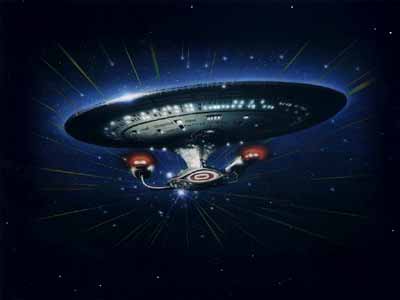
Return
to

|